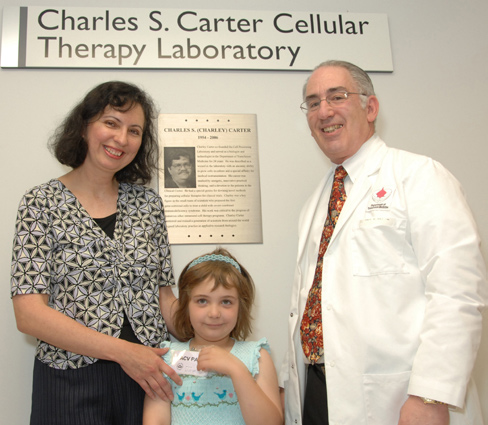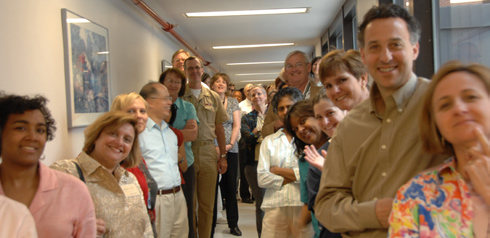 |
 |
Top:
On hand at the unveiling of the plaque dedicating
the new Charles S. Carter Cellular Therapy Laboratory are (from l) Laura Carter, Charley’s widow; Kate Carter, his daughter; and DTM chief Dr. Harvey Klein.
Bottom:
Carter’s colleagues and friends line the hallways around the lab to be present at the dedication. |
The Clinical Center’s department of transfusion medicine (DTM) on June 18 dedicated the Charles S. Carter Cellular Therapy Laboratory within its cell processing
section.
Carter, who died in 2006, co-founded the cell processing
laboratory and worked as a biologist, technologist and supervisor in DTM for 24 years. The words engraved on his plaque describe him as “a wizard in the laboratory with an uncanny ability to grow cells in culture and a special affinity
for medical instrumentation.
His career was marked by energetic, innovative practical thinking,” as well as a devotion to CC patients.
Only a handful of NIH laboratories
or conference rooms are dedicated to individuals, according to DTM chief Dr. Harvey Klein. “A lab is more than just the walls, benches and equipment within it. A lab is also the people who work there and their spirit,” said Klein. “Even those working in this lab today who never knew Charley are imbued with his spirit of creativity.”
DTM hired Carter as a lab technician
in 1982. According to a former staffer, he was “recognized
early on as one of the most skilled and innovative developmental technologists in our field” who usually chose to develop a new procedure rather than rely on one previously used by a colleague.
Carter had a special genius for devising novel methods for preparing cellular
therapies for clinical trials. He was a key figure in a small team of scientists who prepared the first gene-corrected cells to treat a child with severe combined immunodeficiency syndrome.
His work was critical to the progress of numerous other intramural cell therapy programs such as gene marking and gene therapy trials with investigators from several ICs.
In his lifetime, Carter authored or coauthored more than 75 publications on investigative methods for cell collection, ex vivo processing and preservation and characterization and testing of cell therapy products. He received both the Clinical
Center Director’s Award and the NIH Director’s Award.
Several members of the Carter family attended the dedication, including Carter’s widow Laura, a medical technologist in FDA’s Laboratory of Cellular Hematology;
his daughter Kate, his mother Marjorie May Carter and two brothers. 